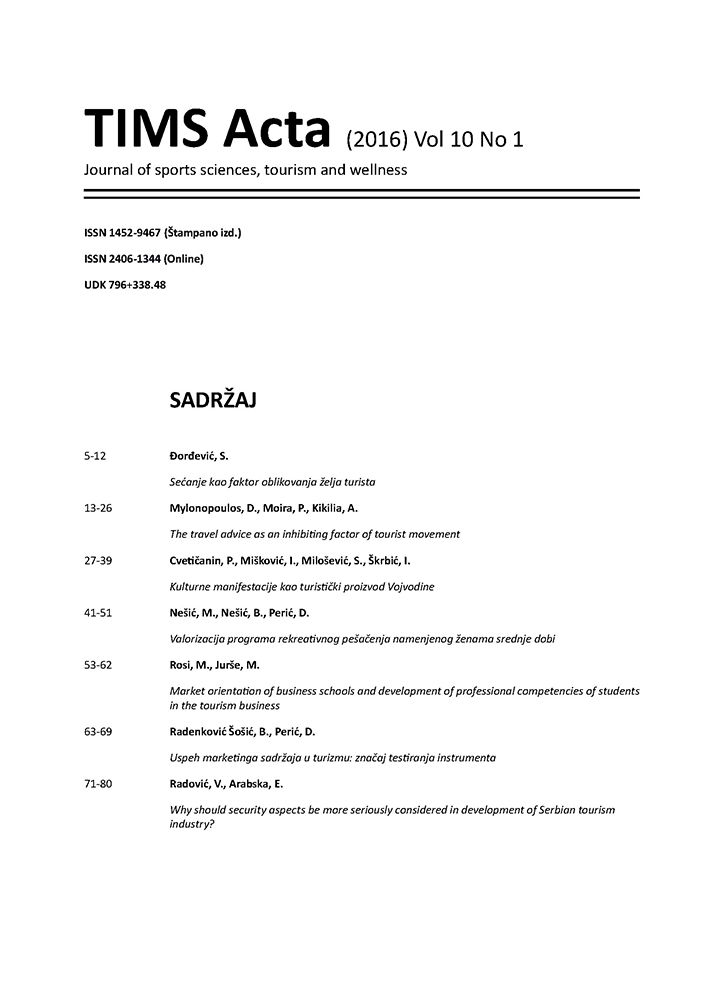THE VALORIZATION OF RECREATIVE PROGRAM OF WALKING BY THE SIDE OF PARTICIPANTS-MIDDLE AGED WOMEN
Abstract
Different programs of walking which are regularly practiced as content of recreation for a period of at least 60 minutes, thee happens in natural enviroment (foothpaths near river, woods, on the mountain, etc.) represent recommended physical activity which can have exceptionally positive influence on keeping and upgrading health. This transversal research was conducted within recreative program „Walking up to Fruska Gora’s monasteries”, with the apply of Survay method. Goal was to make evaluation of some quality aspects of this program based on the perception of direct participants, with the establishment of metric characteristics of the scale PKPP.
On the sample of 31 female sex examinee, aged from 35 to 57 years, questionnaire was applied for a conduct of the elements quality program. By analysis of the Scale Reliability Analysis, we got high Cronbach’s Coeficient Alpha (,826). By Oblimin rotation of main components, we got stable monofactorial structure which shows that questionnaire can be applied as unique scale.
Results of questionnaire found out that participants highly evaluated most of the quality aspects from chosen program of walking. There’s none significant difference between scalar averages got in different subsamples which are formed compared to the years of life and habits for walking as regular recreative activity.
Keywords: walking, recreation, middle-aged woman, valorization
References
Ahmetović, Z., Romanov, R., Dimitrić, M. (2014). Uticaj fizičke aktivnosti na dužinu života ljudi. TIMS Acta, 8, 81-89.
Arsić, M. (2011). Faktori rizika hroničnih nezaraznih bolesti. Novi Sad: Medicinski fakultet. Doktorska disertacija.
Bartlett, M.S. (1954). A note on the multiplyng factors for various chi square approximations. Journal of the Royal Statistical Society, 16 (Series B), 296-298.
Boot, F., Chakravaty, M. (2002). Cost and consequences of sedentary living: New battlerground for an old enemy. President’s Council on Physical Fitness and Sports Research Digest, 3rd ser., no 16.
Carr, J.W. & De Michele, P. (2010). Original Research Service Quality and Satisfaction Within Campus Recreation: The Moderating Role of Identification. Recreational Sports Journal, 34(1), 9-23.
Currie, M.E & Ipson, M.N. (2002). Perceptions of quality services delivery in community recreation. In: Jackson, E. (ed.) (2002). Abstract of Papers Presented at the Tenth Canadian Congress on Leisure Research, Edmonton: Faculty of Physical Education and Recreation, 152-155.
DeVellis, R.F. (2003). Scale development: Theory and applications (2nd ed.). Thousand Oaks, California: Sage.
Đorđević, A. (2005). Rekreacija kao način savremenog življenja. Sportska Medicina, 5(2), 54-78.
Evans, J. R., Lindsey, W. M. (2010). The management and control of quality. USA: South-Western Pub/Thomson.
Farkić, J., Perić, D. (2013). Značaj pešačenja i prohodnosti grada za razvoj urbanog turizma.TIMS Acta, 7, 145-152.
Godin, K., Kok, G. (1996). The theory of planned behavior: A reviev of its applications in health-related behaviors. American journal of helath promotion, 11, 87-98.
Perić, D. i saradnici (2005): Stanje zdravlja stanovništva Vojvodine. Novi Sad: Institut za zaštitu zdravlja.
Grozdanov, J. i saradnici (2007). Istraživanje zdravlja stanovnika Republike Srbije – finalni izveštaj. Beograd: Ministartsvo zdravlja.
Irwin, M.L., Smith, A.W., McTiernan, A., Ballard-Barbash, R., Cronin, K., Gilliland, F.D., Baumgartner, R.N., Baumgartner, K.B. & Bernstein, L. (2008). Influence of Pre-and Postdiagnosis Physical Activity on Mortality in Breast Cancer Survivors: The Health, Eating, Activity, and Lifestyle Study. Journal of Clinical Oncology, 26(24),3958-64.
Jae Ko, Y. & Pastore, L.D. (2004). Current Issues and Conceptualizations of Service Quality in the Recreation Sport Industry. Sport Marketing Quarterly, 13, 158-166.
Kaiser, H. (1970). A second generation Little Jify. Psychometrika, 35, 401-415.
Kaiser, H. (1974). An index of factorial simplicity. Psychometrika, 39, 31-36.
Kattel, R. (1966). The scree test for the number of factors. Multivariate Behavioral Research, 1(2), 245-276.
Kelley, S.W & Turley, L.W. (2001). Consumer perceptions of service quality attributes at sporting events. Journal of Business Research, 54(2), 161-166.
Lee, J.H., Duck Kim, H., Ko, Y. & Sagas, M. (2011). The influence of service quality on satisfaction and intention: A gender segmentation strategy. Sport Management Review, 14(1), 54-63.
Nešić, M., Perić, D., Ahmetović, Z., Zubanov, V. (2014). Some lifestyle traits of Novi Sad students in relation to the subjective perception of health. (In: Pantelić, S.: ed.) Book of Proceedings, XVII Scientific Conference „FIS COMMUNICATIONS 2014" in physical education, sport and recreation, Niš: Faculty of Sport and Physical Education, 388-397.
Packianathan, Ch., Kyungro, Ch. (2000). Targets and Standards of Quality in Sport Services. Sport Management Review, 3(1), 1-22.
Pierro, A., Mannetti, L., Livi, S. (2003). Self-identity and the theory of planned behavior in the prediction of helath behavior and leisure activity. Self & identity, 2, 47-60.
Radoš, J., Nešić, M. (2010). Sport na univerzitetu kao oživotvorenje ideje kalokagatije. Poslovna ekonomija, IV(1),149-156.
Sharrkey, J.B., Gaskill, E.S. (2008). Vežbanje i zdravlje. Beograd: Datastatus.
Statistical Office, United Nations (1982). Provisional guidelines on standard international age classifications. Statistical Papers, Series M No.74, New York: Department of international economic and social affairs.
Zakon o sportu. Vlada Rapublike Srbije, Beograd, „Službeni glasnik RS“, br.24/2011.
World Health Organization. (2006). The World Health Report 2006: Working together for health. http://whqlibdoc.who.int/publications/2006/9241563176_eng.pdf; pristupljeno: 7.06.2015.
- Autori zadržavaju autorska prava i pružaju časopisu pravo prvog objavljivanja rada i licenciraju ga "Creative Commons Attribution licencom" koja omogućava drugima da dele rad, uz uslov navođenja autorstva i izvornog objavljivanja u ovom časopisu.
- Autori mogu izraditi zasebne, ugovorne aranžmane za neekskluzivnu distribuciju članka objavljenog u časopisu (npr. postavljanje u institucionalni repozitorijum ili objavljivanje u knjizi), uz navođenje da je članak izvorno objavljen u ovom časopisu.
- Autorima je dozvoljeno i podstiču se da postave objavljeni članak onlajn (npr. u institucionalni repozitorijum ili na svoju internet stranicu) pre ili tokom postupka prijave rukopisa, s obzirom da takav postupak može voditi produktivnoj razmeni ideja i ranijoj i većoj citiranosti objavljenog članka (Vidi Efekti otvorenog pristupa).

